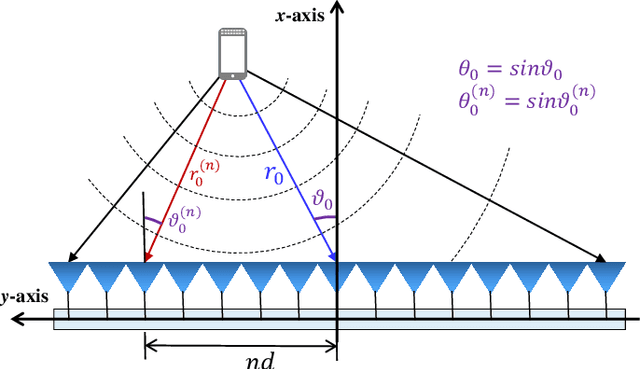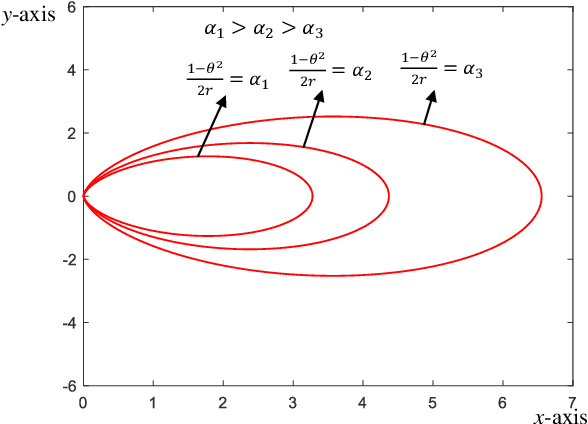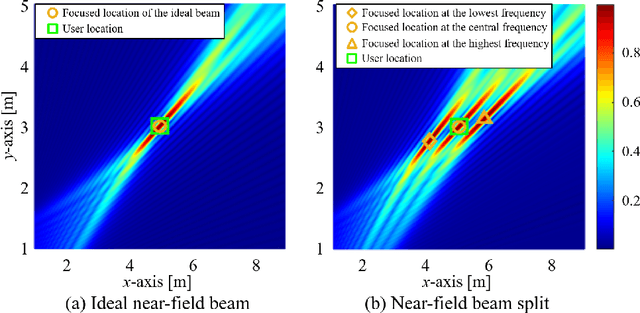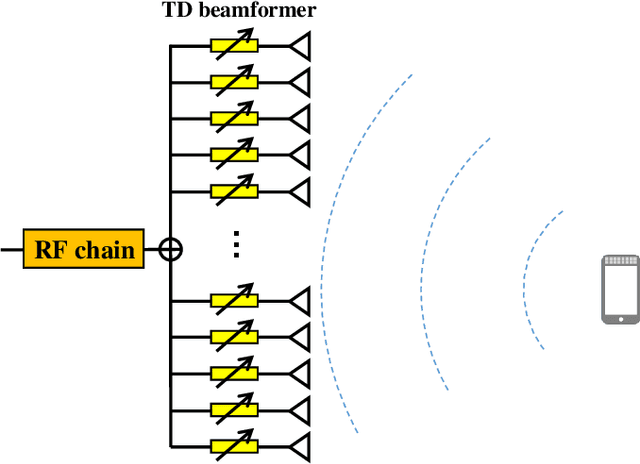Shidong Zhou
Path Evolution Model for Endogenous Channel Digital Twin towards 6G Wireless Networks
Jan 25, 2025



Abstract:Massive Multiple Input Multiple Output (MIMO) is critical for boosting 6G wireless network capacity. Nevertheless, high dimensional Channel State Information (CSI) acquisition becomes the bottleneck of 6G massive MIMO system. Recently, Channel Digital Twin (CDT), which replicates physical entities in wireless channels, has been proposed, providing site-specific prior knowledge for CSI acquisition. However, external devices (e.g., cameras and GPS devices) cannot always be integrated into existing communication systems, nor are they universally available across all scenarios. Moreover, the trained CDT model cannot be directly applied in new environments, which lacks environmental generalizability. To this end, Path Evolution Model (PEM) is proposed as an alternative CDT to reflect physical path evolutions from consecutive channel measurements. Compared to existing CDTs, PEM demonstrates virtues of full endogeneity, self-sustainability and environmental generalizability. Firstly, PEM only requires existing channel measurements, which is free of other hardware devices and can be readily deployed. Secondly, self-sustaining maintenance of PEM can be achieved in dynamic channel by progressive updates. Thirdly, environmental generalizability can greatly reduce deployment costs in dynamic environments. To facilitate the implementation of PEM, an intelligent and light-weighted operation framework is firstly designed. Then, the environmental generalizability of PEM is rigorously analyzed. Next, efficient learning approaches are proposed to reduce the amount of training data practically. Extensive simulation results reveal that PEM can simultaneously achieve high-precision and low-overhead CSI acquisition, which can serve as a fundamental CDT for 6G wireless networks.
Age of Information-Oriented Probabilistic Link Scheduling for Device-to-Device Networks
Oct 26, 2024



Abstract:This paper focuses on optimizing the long-term average age of information (AoI) in device-to-device (D2D) networks through age-aware link scheduling. The problem is naturally formulated as a Markov decision process (MDP). However, finding the optimal policy for the formulated MDP in its original form is challenging due to the intertwined AoI dynamics of all D2D links. To address this, we propose an age-aware stationary randomized policy that determines the probability of scheduling each link in each time slot based on the AoI of all links and the statistical channel state information among all transceivers. By employing the Lyapunov optimization framework, our policy aims to minimize the Lyapunov drift in every time slot. Nonetheless, this per-slot minimization problem is nonconvex due to cross-link interference in D2D networks, posing significant challenges for real-time decision-making. After analyzing the permutation equivariance property of the optimal solutions to the per-slot problem, we apply a message passing neural network (MPNN), a type of graph neural network that also exhibits permutation equivariance, to optimize the per-slot problem in an unsupervised learning manner. Simulation results demonstrate the superior performance of the proposed age-aware stationary randomized policy over baselines and validate the scalability of our method.
Channel Correlation Matrix Extrapolation Based on Roughness Calibration of Scatterers
Sep 17, 2024Abstract:To estimate the channel correlation matrix (CCM) in areas where channel information cannot be collected in advance, this paper proposes a way to spatially extrapolate CCM based on the calibration of the surface roughness parameters of scatterers in the propagation scene. We calibrate the roughness parameters of scene scatters based on CCM data in some specific areas. From these calibrated roughness parameters, we are able to generate a good prediction of the CCM for any other area in the scene by performing ray tracing. Simulation results show that the channel extrapolation method proposed in this paper can effectively realize the extrapolation of the CCM between different areas in frequency domain, or even from one domain to another.
A Dynamic Resource Scheduling Algorithm Based on Traffic Prediction for Coexistence of eMBB and Random Arrival URLLC
Sep 04, 2024Abstract:In this paper, we propose a joint design for the coexistence of enhanced mobile broadband (eMBB) and ultra-reliable and random low-latency communication (URLLC) with different transmission time intervals (TTI): an eMBB scheduler operating at the beginning of each eMBB TTI to decide the coding redundancy of eMBB code blocks, and a URLLC scheduler at the beginning of each mini-slot to perform immediate preemption to ensure that the randomly arriving URLLC traffic is allocated with enough radio resource and the eMBB traffic keeps acceptable one-shot transmission successful probability and throughput. The framework for schedulers under hybrid-TTI is developed and a method to configure eMBB code block based on URLLC traffic arrival prediction is implemented. Simulations show that our work improves the throughput of eMBB traffic without sacrificing the reliablity while supporting randomly arriving URLLC traffic.
Permittivity Estimation in Ray-tracing Using Path Loss Data based on GAMP
Feb 14, 2024Abstract:In this paper, we propose a modified Generalized Approximate Message Passing (GAMP) algorithm to estimate permittivity parameters using path loss data in ray-tracing model.
Joint Analog Encoder Design for Multi-Task Oriented Wireless Communication
May 07, 2023Abstract:In this paper we study multi-task oriented communication system via studying analog encoding method for multiple estimation tasks. The basic idea is to utilize the correlation among interested information required by different tasks and the feature of broadcast channel. For linear estimation tasks, we provide a low complexity algorithm for multi-user multi-task system based on orthogonal decomposition of subspaces. It is proved to be the optimal solution in some special cases, and for general cases, numerical results also show significant improvements over baseline methods. Further, we make a trial to migrate above method to neural networks based non-linear estimation tasks, and it also shows improvement in energy efficiency.
Near-Field Rainbow: Wideband Beam Training for XL-MIMO
May 07, 2022



Abstract:Wideband extremely large-scale multiple-input-multiple-output (XL-MIMO) is a promising technique to achieve Tbps data rates in future 6G systems through beamforming and spatial multiplexing. Due to the extensive bandwidth and the huge number of antennas for wideband XL-MIMO, a significant near-field beam split effect will be induced, where beams at different frequencies are focused on different locations. The near-field beam split effect results in a severe array gain loss, so existing works mainly focus on compensating for this loss by utilizing the time delay (TD) beamformer. By contrast, this paper demonstrates that although the near-field beam split effect degrades the array gain, it also provides a new possibility to realize fast near-field beam training. Specifically, we first reveal the mechanism of the near-field controllable beam split effect. This effect indicates that, by dedicatedly designing the delay parameters, a TD beamformer is able to control the degree of the near-field beam split effect, i.e., beams at different frequencies can flexibly occupy the desired location range. Due to the similarity with the dispersion of natural light caused by a prism, this effect is also termed as the near-field rainbow in this paper. Then, taking advantage of the near-field rainbow effect, a fast wideband beam training scheme is proposed. In our scheme, the close form of the beamforming vector is elaborately derived to enable beams at different frequencies to be focused on different desired locations. By this means, the optimal beamforming vector with the largest array gain can be rapidly searched out by generating multiple beams focused on multiple locations simultaneously through only one radio-frequency (RF) chain. Finally, simulation results demonstrate the proposed scheme is able to realize near-optimal nearfield beam training with a very low training overhead.
 Add to Chrome
Add to Chrome Add to Firefox
Add to Firefox Add to Edge
Add to Edge